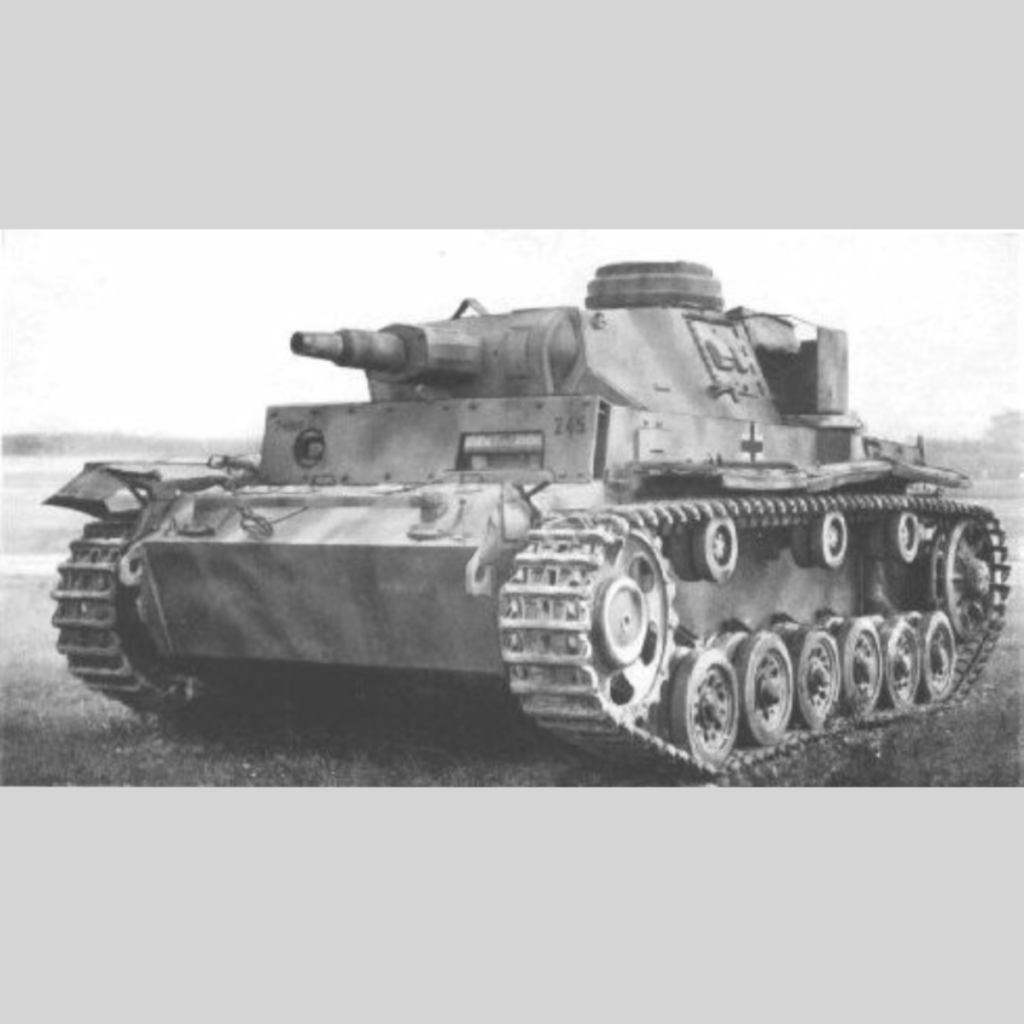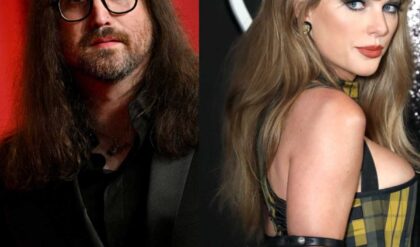
On January 11, 1934, following specifications laid down by Heinz Guderian, the Army Weapons Department drew up plans for a medium tank with a maximum weight of 24,000 kg and a top speed of 35 kilometres per hour (21.75 mph). It was intended as the main tank of the German Panzer divisions, capable of engaging and destroying opposing tank forces.
Daimler-Benz, Krupp, MAN, and Rheinmetall all produced prototypes. Testing of the prototypes took place in 1936 and 1937, leading to the Daimler-Benz design being chosen for production. The first model of the Panzer III, the Ausf. A, came off the assembly line in May 1937, and a total of ten, two of which were unarmed, were produced in 1937. Mass production of the Ausf. F version began in 1939.
Between 1937 and 1940, attempts were made to standardize parts between Krupp’s Panzer IV and Daimler-Benz’s Panzer III.
Much of the early development work on the Panzer III was a quest for a suitable suspension. Several varieties of leaf-spring suspensions were tried on Ausf. A through Ausf. D before the torsion-bar suspension of the Ausf. E was standardized. The Panzer III, along with the Soviet KV heavy tank, was one of the first tanks to use this suspension design.
A distinct feature of Panzer III, influenced by British Vickers tanks, was a three-man turret. This meant that commander was not distracted with either loader’s or gunner’s tasks and could fully concentrate on maintaining situational awareness. Other tanks of the time did not have this capability, providing the Panzer III with a potential combat advantage. For example the French Somua S-35, had only one-man turret crew, and the Soviet T-34 (originally) had two-men. The practical importance of this feature is signified by the fact that not only all the further German tank designs inherited it, but also later into the war, most of the Allied tanks’ designs either quickly switched to the three-man turret, or were abandoned as obsolete.

An early 1941 image of the North Africa campaign – the crew are wearing the original tropical issue pith helmets.
The Panzer III, as opposed to Panzer IV, had no turret basket, merely a foot rest platform for the gunner.
The Panzer III was intended as the primary battle tank of the German forces. However, when it initially met the KV and T-34 tanks it proved to be inferior in both armor and gun power. To meet the growing need to counter these tanks, the Panzer III was up-gunned with a longer, more powerful 50-mm (1.97 in) cannon and received more armor although this failed to effectively address the problem caused by the KV tank designs. As a result, production of self-propelled guns, as well as the up-gunning of the Panzer IV was initiated.
In 1942, the final version of the Panzer III, the Ausf. N, was created with a 75-mm (2.95 in) KwK 37 L/24 cannon, a low-velocity gun designed for anti-infantry and close-support work. For defensive purposes, the Ausf. N was equipped with rounds of hollow charge ammunition which could penetrate 70 to 100 mms (2.76 to 3.94 in) of armor depending on the round’s variant but these were strictly used for self-defense.
The emergence of the Panzer III with 75-mm Gun signalled the fact that the Panzer IV had finally usurped the role of main battle tank relegating the Panzer III to its former role as an infantry support tank. By 1943 with Germany on the defensive there was always the possibility that the Panzer III would meet other tanks with better armor and a far better main armament. The Panzer III Ausf.N was not a success on the battlefield, technology had moved on and production ended early in 1943.
The following intelligence report on the German Panzer III Ausf. N armed with the short 75-mm gun was published in Tactical and Technical Trends, No. 21, March 25, 1943.
PZ. KW. 3 WITH 75-MM GUN
Among enemy tanks recently examined in the Middle East was a Pz. Kw. 3 mounting a short-barreled 75-mm gun (7.5-cm KwK 38), identical with the short-barreled gun mounted on the Pz. Kw. 4. [Recently Pz. Kw. 4’s with a long-barreled 75-mm gun have been encountered by Allied forces (see Tactical and Technical Trends, No. 20, p. 10).] The tank had been demolished, but it appeared that the only alteration, apart from the substitution of the 75-mm gun for the normal 50-mm gun, was the fitting of the armored barrel-sleeve into the front plate of the recoil mechanism belonging to the 75-mm. (Compare accompanying sketch with sketch of Pz. Kw. 3 armed with the long-barreled 50-mm gun, appearing in Tactical and Technical Trends, No. 20, p. 11.)

The German nomenclature for this tank is not known, but recently the Germans have referred to an Einheitspanzer. This is said to be a new standard tank combining the best features of both Pz. Kw. 3 and 4, and to consist of a Pz. Kw. 3 chassis with a short-barreled 75-mm gun mounted in the turret. If this is true, the tank examined may be an Einheitspanzer.
Another Pz. Kw. 3 with the short-barreled 75-mm gun has been captured in Tunisia. Presumably this is the same model tank as that examined in the Middle East.
THE EVOLUTION ON THE PANZER III
Trials and tests of new prototypes took place from 1936 to 1937 on testing grounds in Kummersdorf and Ulm. They resulted in the Daimler-Benz design being chosen for full-scale production and in early 1937, Waffenamt ordered Daimler-Benz to produce the first series (0-Series) of their design.
Krupp’s ZW prototype, designated as MKA, featured leafsprings and bogie wheel mountings type of a suspension. In turn, many features of this vehicle were used in the design of Panzerkampfwagen IV, which was designed by Krupp.
The PzKpfw III design was composed of four sections – hull, turret, and front superstructure with the opening for the turret and rear superstructure with the engine deck. Each section was of a welded construction and all four were bolted together. The hull was divided into two main compartments divided by a bulkhead. The front compartment housed the gearbox and steering mechanism, and the rear one both the fighting and engine compartment. Basic hull, turret, superstructure and crew layout remained unchanged throughout the production life of Panzerkampfwagen III series.
After modifications, the first Panzerkampfwagen III Ausf A (1-Serie) was produced in May of 1937 by Daimler-Benz, with total of 10 produced until the end of 1937 (chassis numbers 60101-60110). Some sources state that as many as 15 were manufactured. Only eight Ausf As were armed (and equipped units of 1st, 2nd and 3rd Panzer Division and took part in the Anschluss, the take-over of Sudetenland and the Polish Campaign) and other unarmed Ausf As were used for further testing.
In 1937, the Ausf B (2-Serie) was produced by Daimler-Benz with total of 15 produced (chassis numbers 60201-60215). A number of Ausf Bs saw service during the Polish Campaign. In October of 1940, five Ausf B tanks were modified and used as prototypes of Sturmgeschutz III series.
In June of 1937, the next variant Ausf C (3a-Serie) was produced by Daimler-Benz and its production ended in January of 1938, again with total of 15 produced (chassis numbers 60301-60315). A number of Ausf Cs saw service during the Polish Campaign.
In January of 1938, the next variant Ausf D (3b-Serie) was produced by Daimler-Benz and its production ended in 1939 with total of 55 produced (chassis numbers 60221-60225 and 60316-60340). Only 30 Ausf Ds produced in two groups of 15 were armed, and another 25 unarmed Ausf Ds were used for further testing. A number of Ausf Ds saw service during the Polish Campaign and in Norway.

A Panzer III advances along a railway line during the early stages of Operation Barbarossa, July 1941.
The warly models of Panzer III (Ausf A, B, C and D) were pre-prototypes of the entire series produced exclusively by Daimler-Benz. All were unsuitable for large-scale production but each new model was considered an improved version of the previous one. Each model featured different type of suspension e.g. Ausf A – individual coil springs, Ausf B – two sets of leaf springs, Ausf C – three sets of leaf springs and Ausf D – angled leaf springs.
Ausf A, B, C and D were powered by 250hp petrol Maybach HL 108 TR engines with a 5 or 6 speed Zahnradfabrik gearbox. All early models were armed with 37mm KwK 35/36 L/46.5 gun and three 7.92mm MG 34 machine guns (two mounted co-axially beside the main armament in the turret and one in the hull). Their armor protection ranged from 5 to 15mm, offering protection only against anti-tank rifles and machine gun fire. The reason behind the inadequate armor protection was a result of Daimler-Benz keeping the vehicle in its designated weight range of 15 tons. Some of early models were up-armored and had their maximum armor protection increased to 30mm. Ausf A, B, C had simple drum shaped “dustbin” commander’s cupolas, while Ausf D had cast cupolas similar to that of the PzKpfw IV Ausf
A few of the early Panzer IIIs saw actual combat (with units of 1st, 2nd and 3rd Panzer Division) during the Polish Campaign, others were troop tested (1937-February 1940). In February of 1940, existing number of early Panzer IIIs was handed over to NSKK for training purposes. Afterwards, only a few Ausf D saw service with PzAbt zbV 40 (along with PzKpfw NbFz VI) during fighting in Norway in April/May of 1940, followed by service with PzAbt zbV 40 in Finland, 1941/42.
Raw Materials Used in Production of PzKpfw III:
•Steel: 39000.00kg
•Tin: 1.40kg
•Copper: 60.10kg
•Aluminium: 90.40kg
•Lead: 71.10kg
•Zinc: 49.10kg
•Rubber: 125.00kg
In December of 1938, the Ausf E (4-serie) entered production, and 96 were produced by Daimler-Benz, Henschel and MAN when production ended in October of 1939 (chassis numbers 60401-60496). It was the first PzKpfw III that was produced in any significant number. The basic design remained unchanged from its predecessor, but it featured a new independent torsion bar suspension, designed by Ferdinand Porsche for the automotive industry in 1930s. It was composed of six roadwheels and three return rollers. The Ausf E was armed with a 37mm KwK 35/36 L/46.5 gun and three 7.92mm MG 34 machine guns (two in the turret and one in the hull). Its armor protection ranged from 12 to 30mm. During production, escape hatches were installed on both sides of the hull and a vision port was added on the superstructure side for the radio-operator. The driver’s visor was provided with an upper and lower sliding shutter, which could be closed together. Also two-piece side hatches were installed in the turret. Unlike its predecessors, the Ausf E was powered by new 300hp petrol Maybach HL120TR engine with a new Maybach Variorex 10 speed gearbox. It was also heavier than all previous models, which were in the 16 ton range but Ausf E weighted 19.5 tons. From August 1940 until 1942, all Ausf E tanks were rearmed with a 50mm KwK 38 L/42 gun mounted in an external mantlet also housing one MG. At the same time, armor protection was increased by the installation of 30mm armor plates to the hull, front and rear, as well as the superstructure front. During service, the number of Ausf E tanks was also reworked to Ausf F standard.
In September 1939, another new variant, the Ausf F (5-serie) entered production. Until July 1940, 435 were produced by Daimler-Benz, Henschel, MAN, Alkett and FAMO (chassis numbers 61001-61650). It was a refined version of the Ausf E and it did not feature any significant modifications or changes other than an improved Maybach HL120TRM engine and modified upper hull nose (with air intakes). The first 335 Ausf F tanks were armed with a 37mm KwK 35/36 L/46.5 gun and three 7.92mm MG 34 machine guns (two in the turret and one in the hull). The last 100 tanks were factory armed with a 50mm KwK 38 L/42 gun mounted in an external mantlet housing one MG. Ausf F vehicles were fitted with a hull rear mounted rack of five smoke generators remotely released from the turret. Some vehicles were also mounted with a stowage box at the rear of the turret. From August 1940 until 1942, all 37mm Ausf F, just as Ausf E tanks, were rearmed with 50mm KwK 38 L/42 guns. They also had their armor protection improved at the same time as Ausf E tanks. Only 40 Ausf F tanks with 50mm KwK 38 L/42 guns were rushed into service before the end of the French Campaign and saw little or no combat. There is still controversy surrounding this as it is reported that the first PzKpfw III armed with 50mm guns entered production in July of 1940. The first production of Sturmgeschutz III assault guns / tank destroyers were based on the Panzerkampfwagen III Ausf F chassis and components. In 1942/43, a number of Ausf F tanks were rearmed with a 50mm KwK 39 L/60 gun. Rearmed and up-armored Ausf F tanks remained in service as late as June of 1944 (e.g. 116th Panzer Division in Normandy).

A Panzer III Ausf L with schurzen in Russia, 1943.
An interesting fact is that the study report of the captured PzKpfw III Ausf F made by the British in 1942, was then sent to United States Army Ordnance Department where it was decided to utilize a copy of German torsion bar suspension system in future American tanks (e.g. M18 Gun Motor Carriage, M24 Chaffee, M26 Pershing etc.).
In 1940/41, attempts were made to standardize the production of Panzer III and Panzer IV. A few prototypes based on the Panzer III Ausf G/H with new large overlapping roadwheels and FAMO suspension were produced – PzKpfw III Ausf G/H mit Schachtellaufwerk. Since 1940, prototypes were used for testing and training purposes. Further development was halted and in 1943/44, prototypes were fitted with dozers and were used to clean up the streets of bombed cities. This suspension was later adopted in Tiger and Panther.
From April 1940 to February 1941, 600 new Ausf G (6-serie) tanks were produced by Daimler-Benz, Henschel, MAN, Alkett, Wegmann, MNH and FAMO (chassis numbers 65001-65950). The Ausf G was a slight improvement over previous Ausf E and Ausf F tanks. Some 50 Ausf G tanks were armed with 37mm KwK 35/36 L/46.5 guns mounted in an internal mantlet, while the rest were armed with a 50mm KwK 38 L/42 gun mounted in an external mantlet. Both 37mm and 50mm tanks had additional two MG 34 machine guns, one in the turret and another in the hull. Armor protection ranged from 12mm to 30mm, although the majority of the protection ranged from 21mm to 30mm. Also a new pivoting visor for the driver (Fahrersehklappe 30) was installed. The turret was modified and mounted on the roof with a fan exhaust and one signal port was eliminated. Mid-production vehicles were mounted with the new type of commander’s cupola as used in the PzKpfw IV Ausf E, F and G, which became standard on all later models of PzKpfw III. Late production vehicles had wider 400mm tracks instead of standard 360mm tracks. The Ausf G was the first to be mounted with the “Rommelkiste” (Rommelbox) – turret mounted storage bin (Gepack Kasten), which then became the standard on all PzKpfw IIIs. From August 1940 until 1942, all 37mm Ausf G tanks just as Ausf E and F tanks were rearmed with the 50mm KwK 38 L/42 gun. Vehicles sent to North Africa were equipped with additional air filters and a different cooling fan reduction ratio. They were designated Ausf G(Tp), Tp being short for Tropisch / Trop / Tropen – tropical. A small number of Ausf G tanks remained in service as late as September 1944.
In October 1940, the Ausf H (7-serie) entered production. It was produced by MAN, Alkett, Henschel, Wegmann, MNH and MIAG until April of 1941 with 308 produced (chassis numbers 66001-66650). The Ausf H featured a newly designed turret to mount a 50mm gun with a single 30mm armor rear plate. Armor protection ranged from 10mm to 30mm, but hull, front and rear, as well as the superstructure front had 30mm armor plates bolted on to them increasing the protection. The increase in armor protection in the Ausf H neutralized the threat of British 2pdr, Soviet 45mm and American 37mm anti-tank guns. The new six speed Maybach SSG 77 gearbox replaced the previously used Variorex. In addition, the suspension system was slightly modified and new sprocket and idler wheels were used in the Ausf H. Consequently, because of the weight gain to 21.8 tons, due to the increase in armor protection, torsion bars were strengthenedd. Originally, the Ausf H was armed with a 50mm KwK 38 L/42 gun and two MG 34 machine guns, but in 1942/43, they were rearmed with a50mm KwK 39 L/60 gun.
Ausf E, F, G and H were designated as Panzerkampfwagen III Ausf E, F, G and H / Sd.Kfz.141.
As of May 10th 1940, the Panzertruppe had only 381 Panzer III models in service, but 135 were lost during the Blitzkrieg in the west.
In March 1941, the last Sd.Kfz.141 and the first Sd.Kfz.141/1 Panzerkampfwagen III tank – Ausf J (8-serie) entered production. It was produced by Daimler-Benz, MAN, Alkett, Henschel, Wegmann, MNH and MIAG until July 1942 with 2616 produced (chassis numbers 68001-69100 and 72001-74100). The Ausf J had its armor protection significantly improved and it ranged from 10mm to 50mm. The increase in armor was accompanied by the installation of the new driver’s visor (Fahrersehklappe 50) and a ballmount (Kugelblende 50) for a 7.92mm MG 34 machine gun in the hull. A new type of front access hatch was installed along with new air intakes on the hull front. From April 1942, 20mm spaced armor was added to the gun mantlet and/or superstructure front. 1549 vehicles produced from March 1941 to July 1942 were armed with a 50mm KwK 38 L/42 gun and two MG 34 machine guns. Those vehicles were designated as PzKpfw III Ausf J / Sd.Kfz.141. 1067 vehicles produced from December 1941 to July 1942, were armed with 50mm KwK 39 L/60 and two MG 34 machine guns. Those vehicles were designated as PzKpfw III Ausf J / Sd.Kfz.141/1. The only difference between these models was the main armament and ammunition stowage for 84 rounds in contrast to the previous 99 rounds. When encountered in North Africa, the British nicknamed the 50mm L/60 Ausf J the “Mark III Special”. The 50mm L/60 gun was a significant improvement over the original 37mm gun, although it was still inadequate to deal with American M4 Sherman and Soviet T-34/76 tanks. In 1941/42, there was an unsuccessful attempt by Krupp to mount the Ausf J with Panzerkampfwagen IV Ausf G’s turret to create a new Panzerkampfwagen III variant designated Ausf K.

A Panzer III in action during the Demjansk pocket battle.
From August to November 1942, 81 Ausf J tanks were produced as command tanks – Panzerbefehlswagen III mit 5cm KwK L/42 / Sd.Kfz.141. From March to September 1943, an additional 104 Ausf J were converted as well. The vehicle was the basic Ausf J tank but it lacked a hull machine gun and carried less ammunition (75 rounds). It was fitted with additional radio equipment and periscope.
In June 1942, the Ausf L tank entered production. 653 were produced by Daimler-Benz, MAN, Alkett, Henschel, Wegmann, MNH and MIAG until December 1942 (chassis numbers 74101-75500). The Ausf L was armed with a 50mm KwK 39 L/60 gun and two 7.92mm MG 34 machine guns. Externally it was almost identical to the late model Ausf J as it was developed by modifying it. The main difference was the new torsion bar gun counter balance, which replaced the original coil spring gun recoil mechanism. Armor protection of the front turret was increased from 30mm to 57mm and 20mm spaced armor was installed on the superstructure front, and in many cases on the gun mantlet. The design of the vehicle was simplified as the rear deck was modified (air-intakes and hatches) and early in production the hull escape hatches, the loader’s vision port on the mantlet and turret side ports were removed. The Ausf L was also mounted with a new special system to transfer heated engine coolant from one vehicle to another. A single Ausf L was mounted with an experimental 75/55mm tapered-bore KwK0725 gun and was designated as PzKpfw III Ausf L mit Waffe 0725. Vehicles send to North Africa were equipped with additional air filters, modified oil filters, a different cooling fan reduction ratio and were designated as Ausf L(Tp). The Ausf L was also first to be mounted with an anti-aircraft machine gun mount (Fliegerbeschussgerat 41/42) on the commander’s cupola. This became standard on all new PzKpfw III tanks and was mounted on older models during service. Many were mounted with 5mm hull and turret armor skirts (Schurzen).
From October 1942 to February 1943, 250 new Ausf M (10-serie) tanks were produced by Wegmann, MIAG, MAN and MNH (chassis numbers 76101-77800). The Ausf M was a late production model Ausf L mounted with new wading equipment allowing wading up to depth of approximately 1.3m, in contrast to the previous 0.8-0.9m. This led to all air inlets and outlets as well as other openings and joints being sealed, while a modified muffler with closure-valve was installed high on the hull rear. The new system was developed and a modified version was used in Tauchpanzer III submersible wading tanks. The hull rear mounted rack of five smoke generators was replaced by three 90mm NbK dischargers mounted forward on both sides of the turret. The Ausf M just as the Ausf L was armed with a 50mm KwK 39 L/60 gun and two 7.92mm MG 34 machine guns. Vehicles produced in 1943 were factory mounted with 5mm hull and turret armor skirts (Schurzen). Large number of Ausf M were converted to either Sturmgeschütz III or Ausf N.
A report on mounting of 50-mm tank gun in German Panzer III tanks, from Tactical and Technical Trends, No. 33, September 9, 1943.
MOUNTING OF 50-MM KW.K 39 TANK GUN

A preliminary examination in the United Kingdom of a captured PzKw 3 Model L (Tp)* has disclosed that the long-barreled 50-mm tank gun, 50-mm Kw. K 39, is balanced by means of a torsion-bar compensator.
As shown in the sketch, the torsion bar is mounted on the inside of the turret roof parallel to the trunnion axis and is anchored at each end. An arm is attached to the center of the bar which carries at its free end a pair of rollers. The bar is pre-set so that the rollers exert a downward force on a flat plate bolted to the gun cradle a few inches from the trunnion axis.
It will be seen from the sketch that, as this plate is fairly close to the trunnion axis, the maximum twist of the bar (from full depression to full elevation) is quite small.
The short tank gun, 50-mm Kw. K, in a captured PzKw 3 Model J previously examined was balanced by a coil spring in compression on the right of the mounting.
*The abbreviation Tp (Tropmunition) following the model-letter of the tank indicates that this tank is adapted for use in the tropics.

Panzerkampfwagen III Ausf E/F in Russian village.
From February 1943 to April 1943, 100 Ausf M tanks produced by MIAG in Braunsweig (chassis numbers 77609-77708) were converted by Wegmann in Kassel to Flammpanzer – flame-thrower tanks. These new vehicles were designated as PzKpfw III (Fl) / Sd.Kfz 141/3. They were also commonly known as Flammpanzer III or Panzerflammwagen III. It was an unmodified Ausf M tank with an additional 30mm to 50mm armor plates welded on for protection to the hull front. This was done because Flammpanzer III tanks had to get closer to their targets and were more vulnerable to enemy fire. In contrast to regular tanks, it was operated by a three men crew composed of commander/flame gunner, radio operator/hull gunner and driver. The main gun and internal ammunition stowage were replaced with the flame-thrower and fuel tanks. This vehicle was armed with a 14mm Flammenwerfer flame-thrower and two 7.92mm MG 34 machine guns. The flame-thrower was mounted in place of the original 50mm gun and concealed in a thick 1.5m long pipe made to appear as standard armament. The flame-thrower could be lowered 8 degrees and raised 20 degrees. Each vehicle carried some 1020 liters of inflammable oil (Flammol) in two tanks inside the vehicle. Oil was pumped into the pipe by a Koebe pump driven by a two-stroke DKW engine, and was ignited by an electric charge (Smitskerzen). The supply of oil allowed some 125 one second or some 80 to 81 two to three seconds long bursts. The maximum range of the flame-thrower was 60m using ignited oil and 50m using cold oil. The range also depended on the weather conditions.
The Flammpanzer III was designed in mind with fighting in the urban areas such as Stalingrad, but it was never to reach its destination. Eventually, the Flammpanzer III equipped the Panzer Regiment’s (Panzer Abteilung) Flame-thrower Platoons (Panzer-Flamm-Zug), each with seven vehicles. A report dated May 5th 1941 gives the following distribution of the vehicles, along with a single vehicle to Schule Wunsdorf:
A report from 1943, states that from March to December, Flammpanzer III tanks were serving with the following Panzer Divisions: 1st, 6th, 11th, 14th, 24th and Grossdeutschland in Russia and the 16th and 26th in Italy. In July 1943, 41 flame-thrower tanks were reported in service with the 6th, 10th and Grossdeutschland Panzer Divisions in preparation for the attack on Kursk. The Flammpanzer III’s design proved to be unsuccessful and vehicles returned for repair were rebuilt into standard combat tanks or Sturmgeschutz III assault guns / tank destroyers. In November 1944, only 10 out of original 100 were repaired and issued to Panzer-Flamm-Kompanie 351, which saw service as late as April of 1945 with Heeres Gruppe Sud. Today, a Panzerkampfwagen III (Fl) (chassis number 77651) captured in Italy can be seen in Koblenz Museum in Germany after being transferred to the museum from Aberdeen Proving Grounds in U.S.A.
In June 1942, the last PzKpfw III model entered production. A new model Ausf N was produced until August 1943 by Henschel, Wegmann, MNH, MIAG and MAN (chassis numbers 73851-77800). Ausf N tanks were produced on Ausf J (3), L (447) and M (213) chassis with total of 663 produced. 37 additional Ausf N tanks were converted from rebuilt older PzKpfw III tanks. The PzKpfw III Ausf N was also known as Sturmpanzer III. The Ausf N was the same as Ausf J, L and M with the main difference being its main armament. It was armed with short 75mm KwK 37 L/24, originally used in PzKpfw IV Ausf A to F1 tanks, which then rearmed with longer 75mm guns. Additional armament consisted of the standard two MG 34 machine guns. The internal ammunition stowage was modified and 56 (based on Ausf L chassis) or 64 (based on Ausf M chassis) rounds were carried. The Ausf N did not have spaced armor as previous models because of the weight of the new 75mm gun. Late production vehicles were fitted with modified type of commander’s cupola with single hatch instead of two-piece one, as well as one-piece side turret hatches. A number of late vehicles were mounted with the commander’s cupola used in PzKpfw IV Ausf G tanks. Vehicles produced from March 1943 were factory mounted with 5mm hull and turret armor skirts (Schurzen). In addition, vehicles produced from early 1943 were factory applied with Zimmerit – anti-magentic paste. PzKpfw III Ausf N tanks were used for close support role. They were either assigned to Tiger Battalions (sPzAbt/sSSPzAbt) as a way to protect them from enemy infantry or to Panzer-Grenadier Divisions. Some sources also state that a variant designated Ausf O existed, although there is no proof of its existence.

Panzerkampfwagen III Ausf L
The interesting fact is that in 1938, work began on the vehicles which were to replace newly introduced Panzerkampfwagen III and Panzerkampfwagen IV. Daimler-Benz was awarded the contract for a new tank, which was to replace Panzerkampfwagen III – VK 2001 (III). It was a completely new design with new chassis and hull layout. It was also designated as GBK – Kampfwagen des Generalbevollmaechtigen (Battle Tank for the Commission for Standardization of Automotive Designs). The work on this tank stopped in December of 1941 and all efforts were focused on the development of a heavier tank – the Panther.
Some of the later Panzer III variants were fitted with turret mounted storage bins (Gepack Kasten). The canister racks mounted on the turret and/or at the rear of the hull were very common. During the early stages of Operation Barbarossa in 1941, Panzer IIIs were equipped with single-axle trailers carrying extra fuel in order to increase their radius of operation. During production, the PzKpfw III’s design underwent many changes including various modifications made on the turret (e.g. cupola, gun mantlet, vision slots, hatches, armor skirts) and hull (e.g. escape hatch, armor skirts) and superstructure (e.g. air intakes, spaced armor, headlights arrangement) components. Since mid 1943, Panzer IIIs were mounted with Schurzen – 5mm armor skirts. During service and repairs, many Panzer III tanks were up-armored, rearmed and re-equipped with new equipment and components creating completely non-standard variants. Vehicles send to North Africa were equipped with additional air filters and different cooling fan reduction ratio. They were designated as (Tp), Tp being short for Tropisch / Trop / Tropen – tropical.

PzKpfw III Ausf N / (Sturmpanzer III) / Sd.Kfz. 141/2
Panzerkampfwagen III saw action in small numbers during the invasion of Poland in September of 1939. The Panzer III was designed as platoon commander’s vehicle (Zugfuhrerwagen) and was Germany’s first true main/medium battle tank. The design of Panzer III came from lessons learned from the combat tested Panzer I and Panzer II. The Panzer III formed the bulk of the Panzer Divisions’ strength during early years of war. By October 1943, only five Panzer Divisions on the Eastern Front had one or more Panzer Company equipped with Panzer IIIs. By late 1944, only 79 Panzer IIIs were in service with frontline units on the Eastern Front. A number of PzKpfw IIIs remained in service until the end of the war in places like Norway and Holland.
The Panzerkampfwagen III’s production was slow and ceased in August of 1943. In the early years, gaps were filled with the Czech PzKpfw 35(t) and PzKpfw 38(t), which possessed a similar combat value. Its design was also a great help in the development of its bigger brother Panzerkampfwagen IV and shared many common parts with it.
Types Ausf A-J(early) (1936-1941) of Panzer III were called “Short” and types Ausf J(late)-N (1941-1943) were called “Long”. Overall around 6000 Panzerkampfwagen IIIs (long and short) were produced. The majority of PzKpfw IIIs were produced by Alkett along with Daimler-Benz, FAMO, Henschel & Sohn, MAN, MIAG, Waggonfabrik Wegmann and MNH.

Panzer III saw an extensive service on all fronts until late 1943, when it was totally replaced by Panzerkampfwagen IV. As a common practice, the Panzer III’s chassis/components became a base for a few conversions and prototypes. By 1943 standards, the Panzer III was obsolete and lost its combat effectiveness which resulted in many being converted to perform various functions.
From February 1942 to April 1944, 262 Panzerkampfwagen III Ausf E/F/Gs were up-armored and converted into Artillerie Panzerbeobachtungswagen III (Sd.Kfz.143) – observation vehicles which served with Wespe and Hummel batteries until the end of the war. Panzerbeobachtungswagen III had a dummy gun mounted and in the place of original gun, Kugelblende (ballmount) for a 7.92mm MG34 machine gun was installed. The Sd.Kfz.143 had a crew of five and was equipped with powerful radio equipment.
In 1943, some Ausf L and Ms were converted into turretless Pionierpanzerwagen III – engineer tanks mounted with additional equipment. In mid 1944, 176 Panzer IIIs (including Ausf E, F and G) were converted into Bergepanzer IIIs – recovery vehicles fitted with additional equipment. Also in 1943/44 a number of early Panzer IIIs was converted into Schlepper – artillery tractors and Munitionspanzer – ammunition carriers.
One of the most interesting prototypes based on the Panzer III’s chassis was the Minenraumpanzer III – a mine clearing/mine destroyer tank developed by Krupp. It proved to be unsuccessful and never entered production.
In October of 1943, a prototype of PzKpfw III Ausf N als Schienen-Kettenfahrzeug was tested. Three Ausf Ns (mounted with railway suspension by Sauer Werke of Vienna) were converted to travel by rail at maximum speed of 100km/h. They were to be used to protect the rail network behind the frontlines in the East. Only three prototypes were produced but further development of this project was cancelled.

Minenraumpanzer III / Minenraumgerat mit PzKpfw Antrieb.
From June 1938 to February 1943, a number of Panzer IIIs were converted by Daimler-Benz to Panzerbefehlswagens III Ausf D1 (30), Ausf E (45) and Ausf H (175) (Sd.Kfz.266-268) command tanks equipped with extra radios and additional equipment and saw active service until the end of the war. Command tanks were mounted with a dummy gun and were armed only with a single 7.92mm MG machine gun. 185 Panzerbefehlswagen III mit 5cm KwK L/42 (based on Ausf J) and 50 Ausf K (based on Ausf L) were armed with 50mm L/42 and 50mm L/60 guns respectively.

Turrets removed from PzKpfw IIIs converted to other vehicles were used in fortifications of the Atlantic Wall and Hitler’s Line in Italy. In 1945, it was decided to utilize the obsolete PzKpfw III and mount it with Wirbelwind or Ostwind turrets, designated as Flakpanzer III. 90 were ordered but the end of the war terminated the production.
The most interesting field conversion was created by the field workshops of the Afrika Korps in North Africa, who converted a damaged Panzerkampfwagen III Ausf H to 150mm s.I.G.33 gun carrier by using components (such as gun itself, gun shield, superstructure sides with tool stowage and ammunition racks) from Sturmpanzer II Bison (lengthened version).
The Panzerkampfwagen III was also exported to other nations, especially Germany’s Allies or pro-German states. The first country to receive the PzKpfw III was Hungary (10), followed by Romania (11 Ausf N), Bulgaria (10 Ausf N) and Slovakia (7 Ausf N). A small number of Ausf L and N tanks was also exported to Croatia. A large number (56) was ordered by Turkey but the transaction was never finalized due to the war situation, although supposedly some (20-22?) were delivered.

PzKpfw III Ausf G and IV Ausf F1 of Lt. N.Baryshev’s platoon from 107th Independent Tank Battalion, Volkhov Front, July 6th of 1942.
From 1941 to 1943, Russians captured large numbers of PzKpfw III, Sturmgeschutz III and PzKpfw IV. Some were pressed into temporary service (e.g. being used as “Trojan Horses” or as “bait”) , while some were converted to assault guns designated SU-76i and SG-122A.
An interesting fact is that the Polish Tank Platoon of the Carpathian Lancers received captured PzKpfw III for training purposes, while in Egypt in August of 1942.
The most successful conversion based on the Panzerkampfwagen III’s chassis was the Sturmgeschutz III – assault gun/tank destroyer series – which remained in service with the Finnish Army as late as 1967.
After the war ended, some 32 PzKpfw III were used by Norway along with Stug III Ausf Gs.
A small number of PzKpfw III tanks was also used by Czechoslovakia, including four rebuild Flammpanzer III tanks.
The Panzerkampfwagen III gained a reputation for being a highly reliable and effective vehicle, which shaped tank development plans of both German and Allied tank builders. It was the best German tank in the first part of the war, but by 1943 it was largely obsolete.

Panzerkampfwagen III Ausf H(U) – Tauchfahig (U-Panzer / Submersible Tank)
This U-Panzer belonged to the 18th Panzer Division’s 18th Panzer Regiment. This photo was taken during the crossing of the River Bug at Patulin on 22nd June of 1941. During the preparation for the invasion of England – Operation Seelöwe (Sealion) – Panzer IIIs and Panzer IVs were converted into submersible tanks able to travel on the bottom of a body of water at the depths of 6 to 15 meters. From June to October of 1940, 160 Panzer III Ausf F/G/H and 8 Panzerbefehlswagen III Ausf E along with 42 Panzer IV Ausf Ds were converted into U-Panzers / Tauchpanzers. After extensive tests and modifications U-Panzer were ready for action. Since Operation Sealion was never realized, Tauchpanzer IIIs and IVs were used during Operation Barbarossa (crossing river Bug at Patulin), in service with 3rd (6th Panzer Regiment) and 18th Panzer Division. It was also planned to use U-Panzers in the aborted invasion on the island of Malta.
Specifications








